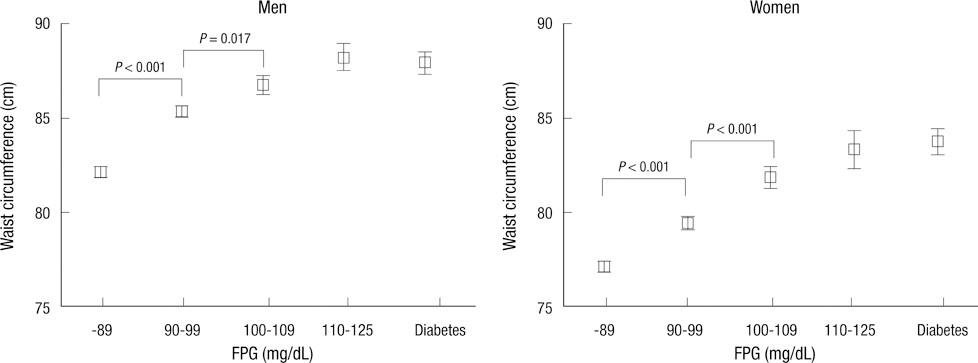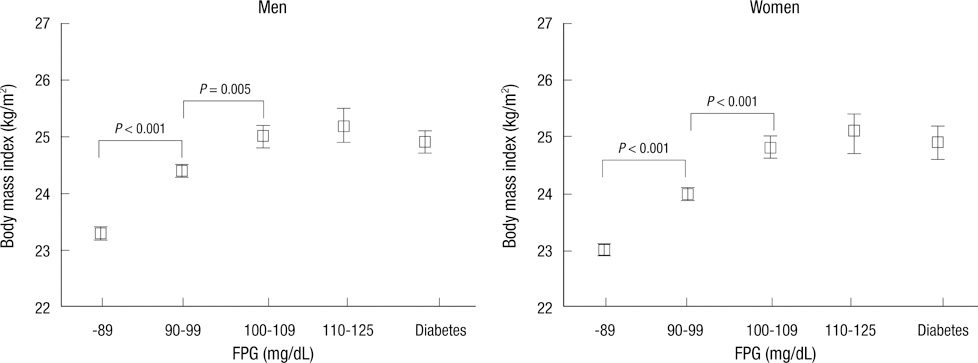J Korean Med Sci.
2012 May;27(5):518-524. 10.3346/jkms.2012.27.5.518.
Body Mass Index and Waist Circumference According to Glucose Tolerance Status in Korea: The 2005 Korean Health and Nutrition Examination Survey
- Affiliations
-
- 1Department of Internal Medicine, Inje University College of Medicine, Goyang, Korea. djkim@paik.ac.kr
- KMID: 1372794
- DOI: http://doi.org/10.3346/jkms.2012.27.5.518
Abstract
- The purpose of this study was to investigate the stage of glucose intolerance in which persons showed a maximum obesity in Korea. A total of 4,479 participants, who were involved in the 2005 Korean National Health and Nutrition Examination Survey, was examined. The participants were divided into 5 groups by fasting plasma glucose (FPG); normal fasting glucose (NFG)1, FPG < 90 mg/dL; NFG2, FPG 90-99 mg/dL; impaired fasting glucose (IFG)1, FPG 100-109 mg/dL; IFG2, FPG 110-125 mg/dL; and diabetes mellitus, FPG > or = 126 mg/dL or with anti-diabetes drugs. In those with FPG < 110 mg/dL, body mass index (BMI) and waist circumference (WC) were increased with increase of FPG (BMI in men; NFG1, 23.3 +/- 0.1; NFG2, 24.4 +/- 0.1; IFG1, 25.0 +/- 0.2 kg/m2, in women; NFG1, 23.0 +/- 0.1; NFG2, 24.0 +/- 0.1; IFG1, 24.8 +/- 0.2 kg/m2, WC in men; NFG1, 82.1 +/- 0.3; NFG2, 85.3 +/- 0.3; IFG1, 86.7 +/- 0.5 cm, in women; NFG1, 77.1 +/- 0.2; NFG2, 79.4 +/- 0.3; IFG1, 81.8 +/- 0.6 cm). In IFG2 and diabetes range, there was no more increase of BMI and WC with increase of FPG in each sex. The data suggest that degree of obesity increases with an increase of FPG in range of FPG < 100 mg/dL, peaked in FPG of 100-109 mg/dL, and then plateaus in higher FPG range in general Korean population.
Keyword
MeSH Terms
Figure
Reference
-
1. Ford ES, Williamson DF, Liu S. Weight change and diabetes incidence: findings from a national cohort of US adults. Am J Epidemiol. 1997. 146:214–222.2. Hartemink N, Boshuizen HC, Nagelkerke NJ, Jacobs MA, van Houwelingen HC. Combining risk estimates from observational studies with different exposure cutpoints: a meta-analysis on body mass index and diabetes type 2. Am J Epidemiol. 2006. 163:1042–1052.3. Rhee EJ, Choi JH, Yoo SH, Bae JC, Kim WJ, Choi ES, Park SE, Park CY, Park SW, Oh KW, et al. The association of unintentional changes in weight, body composition, and homeostasis model assessment index with glycemic progression in non-diabetic healthy subjects. Diabetes Metab J. 2011. 35:138–148.4. Knowler WC, Barrett-Connor E, Fowler SE, Hamman RF, Lachin JM, Walker EA, Nathan DM. Diabetes Prevention Program Research Group. Reduction in the incidence of type 2 diabetes with lifestyle intervention or metformin. N Engl J Med. 2002. 346:393–403.5. Tuomilehto J, Lindström J, Eriksson JG, Valle TT, Hämäläinen H, Ilanne-Parikka P, Keinänen-Kiukaanniemi S, Laakso M, Louheranta A, Rastas M, et al. Prevention of type 2 diabetes mellitus by changes in lifestyle among subjects with impaired glucose tolerance. N Engl J Med. 2001. 344:1343–1350.6. Gautier A, Roussel R, Ducluzeau PH, Lange C, Vol S, Balkau B, Bonnet F. DESIR Study Group. Increases in waist circumference and weight as predictors of type 2 diabetes in individuals with impaired fasting glucose: influence of baseline BMI: data from the DESIR study. Diabetes Care. 2010. 33:1850–1852.7. Ohlson LO, Larsson B, Svärdsudd K, Welin L, Eriksson H, Wilhelmsen L, Björntorp P, Tibblin G. The influence of body fat distribution on the incidence of diabetes mellitus. 13.5 years of follow-up of the participants in the study of men born in 1913. Diabetes. 1985. 34:1055–1058.8. Yoon KH, Lee JH, Kim JW, Cho JH, Choi YH, Ko SH, Zimmet P, Son HY. Epidemic obesity and type 2 diabetes in Asia. Lancet. 2006. 368:1681–1688.9. Park SW, Yun YS, Song YD, Lee HC, Huh KB. Pathogenetic heterogeneity of type 2 diabetes mellitus in Korea. J Korean Diabetes Assoc. 1999. 23:62–69.10. Suk JH, Choi J, Kim YW, Park JS, Kim JS, Kim MK, Choi SY, Park JH, Rhee BD. Analysis of the body mass index of newly diagnosed type 2 diabetic patients and its temporal trends. J Korean Diabetes Assoc. 2003. 27:132–140.11. Huxley R, JamesWP , Barzi F, Patel JV, Lear SA, Suriyawongpaisal P, Janus E, Caterson I, Zimmet P, Prabhakaran D, et al. Ethnic comparisons of the cross-sectional relationships between measures of body size with diabetes and hypertension. Obes Rev. 2008. 9:53–61.12. Kim DJ, Lee MS, Kim KW, Lee MK. Insulin secretory dysfunction and insulin resistance in the pathogenesis of Korean type 2 diabetes mellitus. Metabolism. 2001. 50:590–593.13. Fukushima M, Usami M, Ikeda M, Nakai Y, Taniguchi A, Matsuura T, Suzuki H, Kurose T, Yamada Y, Seino Y. Insulin secretion and insulin sensitivity at different stages of glucose tolerance: a cross-sectional study of Japanese type 2 diabetes. Metabolism. 2004. 53:831–835.14. Kuroe A, Fukushima M, Usami M, Ikeda M, Nakai Y, Taniguchi A, Matsuura T, Suzuki H, Kurose T, Yasuda K, et al. Impaired beta-cell function and insulin sensitivity in Japanese subjects with normal glucose tolerance. Diabetes Res Clin Pract. 2003. 59:71–77.15. Looker HC, Knowler WC, Hanson RL. Changes in BMI and weight before and after the development of type 2 diabetes. Diabetes Care. 2001. 24:1917–1922.16. de Fine Olivarius N, Richelsen B, Siersma V, Andreasen AH, Beck-Nielsen H. Weight history of patients with newly diagnosed type 2 diabetes. Diabet Med. 2008. 25:933–941.17. Abdullah A, Peeters A, de Courten M, Stoelwinder J. The magnitude of association between overweight and obesity and the risk of diabetes: a meta-analysis of prospective cohort studies. Diabetes Res Clin Pract. 2010. 89:309–319.18. Koh-Banerjee P, Wang Y, Hu FB, Spiegelman D, Willett WC, Rimm EB. Changes in body weight and body fat distribution as risk factors for clinical diabetes in US men. Am J Epidemiol. 2004. 159:1150–1159.19. Jeffreys M, Lawlor DA, Galobardes B, McCarron P, Kinra S, Ebrahim S, Smith GD. Lifecourse weight patterns and adult-onset diabetes: the Glasgow Alumni and British Women's Heart and Health studies. Int J Obes (Lond). 2006. 30:507–512.20. Black E, Holst C, Astrup A, Toubro S, Echwald S, Pedersen O, Sørensen TI. Long-term influences of body-weight changes, independent of the attained weight, on risk of impaired glucose tolerance and Type 2 diabetes. Diabet Med. 2005. 22:1199–1205.21. Wannamethee SG, Shaper AG. Weight change and duration of overweight and obesity in the incidence of type 2 diabetes. Diabetes Care. 1999. 22:1266–1272.22. Song TH, Choi BR, Tak SM, Kang JW, Kim CE, Moon FC, Woo JT. A retrospective study on body weight of diabetes in Korea. J Korean Diabetes Assoc. 1990. 14:229–233.23. Park JY, Kim HK, Kim MS, Park KS, Kim SY, Cho BY, Lee HK, Koh CS, Min HK. Body weight changes of non-insulin dependent diabetic patients in Korea. J Korean Diabetes Assoc. 1993. 17:51–58.24. Sung EJ, Sunwoo S, Kim SW, Kim YS. Obesity as a risk factor for non-insulin-dependent diabetes mellitus in Korea. J Korean Med Sci. 2001. 16:391–396.25. Ko SH, Kim SR, Kim DJ, Oh SJ, Lee HJ, Shim KH, Woo MH, Kim JY, Kim NH, Kim JT, et al. 2011 clinical practice guidelines for type 2 diabetes in Korea. Diabetes Metab J. 2011. 35:431–436.26. Kim DJ, Kim KW, Cho NH, Noh JH, Lee MS, Lee MK. The cutoff value of fasting plasma glucose to differentiate frequencies of cardiovascular factors in a Korean population. Diabetes Care. 2003. 26:3354–3356.27. Oh JY, Lim S, Kim DJ, Kim NH, Kim DJ, Moon SD, Jang HC, Cho YM, Song KH, Ahn CW, et al. A report on the diagnosis of intermediate hyperglycemia in Korea: a pooled analysis of four community-based cohort studies. Diabetes Res Clin Pract. 2008. 80:463–468.28. Nguyen NT, Nguyen XM, Lane J, Wang P. Relationship between obesity and diabetes in a US adult population: findings from the National Health and Nutrition Examination Survey, 1999-2006. Obes Surg. 2011. 21:351–355.29. Ni Mhurchu C, Parag V, Nakamura M, Patel A, Rodgers A, Lam TH. Asia Pacific Cohort Studies Collaboration. Body mass index and risk of diabetes mellitus in the Asia-Pacific region. Asia Pac J Clin Nutr. 2006. 15:127–133.30. Lee TH. Prevalence of obesity in Korean non-insulin-dependent diabetic patients. Diabetes Res Clin Pract. 1996. 32:71–80.31. Fujimoto WY, Akanuma Y, Kanazawa Y, Mashiko S, Leonetti D, Wahl P. Plasma insulin levels in Japanese and Japanese-American men with type 2 diabetes may be related to the occurence of cardiovascular disease. Diabetes Res Clin Pract. 1989. 6:121–127.32. Weyer C, Bogardus C, Mott DM, Pratley RE. The natural history of insulin secretory dysfunction and insulin resistance in the pathogenesis of type 2 diabetes mellitus. J Clin Invest. 1999. 104:787–794.33. Phillips DI, Clark PM, Hales CN, Osmond C. Understanding oral glucose tolerance: comparison of glucose or insulin measurements during the oral glucose tolerance test with specific measurement of insulin resistance and insulin secretion. Diabet Med. 1994. 11:286–292.34. Matthews DR, Hosker JP, Rudenski AS, Naylor BA, Treacher DF, Turner RC. Homeostasis model assessment: insulin resistance and beta-cell function from fasting plasma glucose and insulin concentrations in man. Diabetologia. 1985. 28:412–419.
- Full Text Links
- Actions
-
Cited
- CITED
-
- Close
- Share
- Similar articles
-
- What is the Most Reliable Obesity Iindex in Korean Elderly Population?
- Risk Factors affecting Dyslipidemia according to Age Group in Women:Data from the Korea National Health and Nutrition Examination Survey, 2014~2017
- Health and Nutritional Factors Related to Hypertension of Subjects Aged Over 50 in High Income Class : Based on the 2005 Korea National Health and Nutrition Examination Survey
- The Comparison of Efficacy of Obesity Indices for Screening Metabolic Risk Factors Among Adults In Jeju Island
- Relationship between Zinc Status and Obesity of Type 2 Diabetic Women



